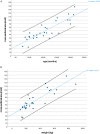Nerve ultrasound reference values in children and adolescents: Echogenicity and influence of anthropometric factors including hand volume
- PMID: 37621670
- PMCID: PMC10446961
- DOI: 10.1177/11795735231195778
Nerve ultrasound reference values in children and adolescents: Echogenicity and influence of anthropometric factors including hand volume
Abstract
Background: Nerve cross-sectional area (CSA) reference values in high-resolution ultrasound for children and adolescents are influenced by demographic and anthropometric factors such as age, height and weight.
Objectives: The influence of hand volume as an additional morphometric factor was evaluated and nerve echogenicity was analyzed in a prospective cross-sectional study.
Methods: CSA were measured in 30 healthy children and adolescents from 2 to 17 years in the median, ulnar, radial, tibial, peroneal and sural nerves. Height, weight, age, handedness and gender were recorded, the volume of the hands was measured using the water displacement method. The intra-nerve CSA variability (INV), left/right ratios and absolute differences were calculated. Age groups were compared by the Kruskal-Wallis test. The influence of demographic factors was analyzed using Spearman correlation and multiple linear regression. Echogenicity and fraction of black were determined for each nerve segment.
Results: Nerve CSA values were consistently lower than those reported for adults and correlated in all measured nerve sites with age, height, weight and hand volume. Weight showed the highest correlation coefficient (R = .95) with the best fitting model predicting CSA. Correlation coefficients were higher in a linear than in a logarithmic model. Ratios were stable, the absolute differences increased with age and were significantly different between age groups. Most nerves showed a mixed or hypoechogenic pattern in echogenicity analysis, hyperechogenicity is less frequently observed.
Conclusions: Nerve CSA in children and adolescents is lower than in adults and increases proportionally during growth with a constant INV and left/right ratio in different age groups. Weight and age are predominant anthropometric factors predicting nerve size. Hand volume is correlated with nerve size, but does not predict CSA independently. Echogenicity can provide additional information on nerve structure.
Keywords: High-resolution nerve ultrasound; demographic factors; echogenicity; hand volume; pediatric reference values.
© The Author(s) 2023.
Conflict of interest statement
The author(s) declared no potential conflicts of interest with respect to the research, authorship, and/or publication of this article.
Figures







References
LinkOut - more resources
Full Text Sources
Medical

